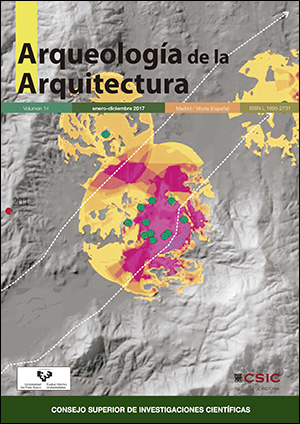Invisible masons. An approximation to the study of the pit pattern of La Ventilla, Teotihuacan
DOI:
https://doi.org/10.3989/arq.arqt.2017.001Keywords:
Teotihuacan, masons, scaffolding, ladders, falseworkAbstract
This article was born with a desire, and talk about architecture of the ancient city of Teotihuacan (Mexico), without the guilds of stonemasons who made it possible and whose activities have not figured within the academic concerns of specialists and this pre-Columbian metropolis. Therefore, as part of archaeological explorations in the Teotihuacan neighborhood of La Ventilla and particularly the discovery of enigmatic patterns of pits on their floors, is that we do exercises of experimental archeology in order to approach some operations, techniques and engineering solutions that routinely performing these builders as part of their basic subsistence. An attempt to scale their technical relevance and social importance of these associations in the universe of ancient architecture.
Downloads
References
Adam, J.-P. 2002: La Construcción Romana, 2ª ed. Editorial de los Oficios. España.
Alvarado, J. L. 2012: Informe de las muestras de tierra de las fosas de La Ventilla. Manuscrito para Archivo técnico de la Zona Arqueológica de Teotihuacan. México.
Botero, R. 2006: Encofrados. Documento de Trabajo. Universidad Nacional de Colombia, Medellin.
Brogiolo, G. P. 1996: "Prospettive per l'archeologia dell'architettura", Archeologia dell'architettura, I, pp. 11-15
Cabrera Castro, R. 2000: Informe de las excavaciones realizadas en La Ventilla, Teotihuacán Temporada 2000. Mecanuscrito, Archivo del Proyecto La Ventilla, Teotihuacán.
Cagnana, A. 2000: Archeologia dei materiali da costruzione. Mantova
Cassanelli, R. (ed.) 1995: Talleres de arquitectura en la Edad Media. Barcelona.
Delgado Rubio, J. 2015: "Los poderes intermedios del Estado en el barrio teotihuacano de La Ventilla", Revista de Arqueología 48, SEP- INAHCONACULTA, México.
Fiorandi, D. 1996: Tecniche costruttive murarie medievali: il Lazio meridionale, Roma.
Gómez Chávez, S. 1995: "Los barrios y sus componentes en Teotihuacán: Notas para el desarrollo de un modelo de articulación urbana", Revista Dimensión Antropológica No. 65. INAH- CONACULTA. México
Gómez Chávez, S. y King, T. 2000: "Avances en el desciframiento de la escritura jeroglífica de Teotihuacán", en Memorias de la Segunda Mesa Redonda de Teotihuacán. Centro de Estudios Teotihuacanos/ INAHCONACULTA, México.
Kimpel, D. 1977: "Le développement et la taille en série dans l'architecture médiévale et son rôle dans l'histoire économique", Bulletin Monumental, 177, pp. 195-222. https://doi.org/10.3406/bulmo.1977.5607
Mannoti, T. 1994: Caratteri costruttivi dell'edilizia storica. Genova
Mannoti, T. 1997: "Il problema complesso delle murature storiche in pietra 1. Cultura materiale e cronotipologia", Archeologia dell'Architettura II, pp. 15-24.
Manzanilla, L. 1996: "Corporate groups and domestic activities at Teotihuacan", Latin American Antiquity. Society for American Archaeology, 7, 3, pp. 228-246. https://doi.org/10.2307/971576
Margain, C. 1966: "Sobre los sistemas y materiales de construcción en Teotihuacan", en XI Mesa Redonda de la Sociedad Mexicana de Antropología. UNAM, México.
Millon, R. 1966: "Extensión y población de la ciudad de Teotihuacan en sus diferentes periodos", en XI Mesa Redonda de la Sociedad Mexicana de Antropología. UNAM, México.
Millon, R. 1973: Urbanization at Teotihuacan. Austin, Texas University Press. PMid:4769457
Morelos, N. 1985: Proceso de producción de espacios y estructuras en Teotihuacan. Conjunto Plaza Oeste y Complejo Calle de los Muertos. Tesis de Licenciatura, ENAH-INAH, México.
Mosser, F. 1968: "Geografía y desarrollo del valle de Teotihuacan", en Lorenzo, J. L. (ed.), Materiales para la arqueología de Teotihuacan. Serie Investigaciones 17. INAH, México.
Smith, M. E. y Paz Bautista, C. 2015: "Las almenas de la antigua ciudad de Teotihuacan", Mexicon, 37, 5, pp. 118-125.
Toreli, M. 1980: "Innovazioni nelle tecniche edilizie romane tra il I sec. a. C. e il I sec. d. C.", en Tecnologia, economia e società nel mondo romano, pp. 139-162
Published
How to Cite
Issue
Section
License
Copyright (c) 2017 Consejo Superior de Investigaciones Científicas (CSIC) - Universidad del País Vasco/Euskal Herriko Unibertsitatea (UPV/EHU)

This work is licensed under a Creative Commons Attribution 4.0 International License.
© CSIC. © UPV/EHU. Manuscripts published in both the print and online versions of this journal are the property of Consejo Superior de Investigaciones Científicas and Universidad del País Vasco/Euskal Herriko Unibertsitatea, and quoting this source is a requirement for any partial or full reproduction.
All contents of this electronic edition, except where otherwise noted, are distributed under a Creative Commons Attribution 4.0 International (CC BY 4.0) licence. You may read the basic information and the legal text of the licence. The indication of the CC BY 4.0 licence must be expressly stated in this way when necessary.
Self-archiving in repositories, personal webpages or similar, of any version other than the final version of the work produced by the publisher, is not allowed.















